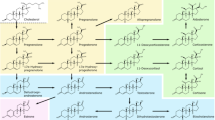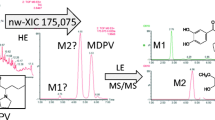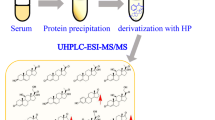Abstract
Profiling conjugated urinary steroids to detect anabolic-steroid misuse is recognized as an efficient analytical strategy in both chemical-food-safety and anti-doping fields. The relevance and robustness of such profiling rely on the analysis of glucuronide and sulfate steroids, which is expected to have properties including accuracy, specificity, sensitivity, and, if possible, rapidity. In this context, the ability of ultra-high-performance supercritical-fluid chromatography (UHPSFC) hyphenated tandem mass spectrometry (MS–MS) to provide reliable and accurate phase II analysis of steroids was assessed. Four stationary phases with sub-2 μm particles (BEH, BEH 2-ethyl-pyridine, HSS C18 SB, and CSH fluorophenyl) were screened for their capacity to separate several conjugated steroid isomers. Analytical conditions including stationary phase, modifier composition and percentage, back pressure, column temperature, and composition and flow rate of make-up solvent were investigated to improve the separation and/or the sensitivity. Thus, an analytical procedure enabling the analysis of eight glucuronide and 12 sulfate steroids by two different methods in 12 and 15 min, respectively, was optimized. The two procedures were evaluated, and UHPSFC–MS–MS analysis revealed its ability to provide sensitive (limits of quantification: 0.1 ng mL−1 and 0.5 ng mL−1 for sulfate and glucuronide steroids, respectively) and reliable quantitative performance (R 2 > 0.995, RSD < 20 %, and bias < 30 %) through the use of suitable labeled internal standards. Comparison with UHPLC–MS–MS was performed, and UHPSFC–MS–MS obtained better performance in terms of sensitivity. Finally, as a proof of concept, this so-called green technology was used in a chemical-food-safety context to profile steroid conjugates in urine samples from bovines treated with estradiol.

Glucuronide and sulfate steroids analysis in urine by ultra-high performance supercritical fluid chromatography hyphenated tandem mass spectrometry





Similar content being viewed by others
References
European Council Directive 96/22/EC of 29 April 1996 concerning the prohibition on the use in stockfarming of certain substances having a hormonal or thyrostatic action and of beta-agonists, and repealing Directives 81/602/EEC, 88/146/EEC and 88/299/EEC. OJ L125, 23.5.1996, p.3. 1996
Anizan S, Bichon E, Di Nardo D, Monteau F, Cesbron N, Antignac JP, Le Bizec B (2011) Screening of 4-androstenedione misuse in cattle by LC-MS/MS profiling of glucuronide and sulfate steroids in urine. Talanta 86:186–194
Anizan S, Di Nardo D, Bichon E, Monteau F, Cesbron N, Antignac JP, Le Bizec B (2011) Targeted phase II metabolites profiling as new screening strategy to investigate natural steroid abuse in animal breeding. Anal Chim Acta 700:105–113
Blokland MH, Van Tricht EF, Van Rossum HJ, Sterk SS, Nielen MW (2012) Endogenous steroid profiling by gas chromatography-tandem mass spectrometry and multivariate statistics for the detection of natural hormone abuse in cattle. Food Addit Contam Part A 29:1030–1045
Dervilly-Pinel G, Rambaud L, Sitthisack P, Monteau F, Hewitt SA, Kennedy DG, Le Bizec B (2011) 5α-Estrane-3β,17β-diol and 5β-estrane-3α,17β-diol: Definitive screening biomarkers to sign nandrolone abuse in cattle? J Steroid Biochem Mol Biol 126:65–71
Destrez B, Bichon E, Rambaud L, Courant F, Monteau F, Pinel G, Antignac JP, Le Bizec B (2009) Criteria to distinguish between natural situations and illegal use of boldenone, boldenone esters and boldione in cattle 2. Direct measurement of 17beta-boldenone sulpho-conjugate in calf urine by liquid chromatography-high resolution and tandem mass spectrometry. Steroids 74:803–808
Pinel G, Rambaud L, Monteau F, Elliot C, Le Bizec B (2010) Estranediols profiling in calves’ urine after 17β-nandrolone laureate ester administration. J Steroid Biochem Mol Biol 121:626–632
Pinel G, Weigel S, Antignac JP, Mooney MH, Elliott C, Nielen MWF, Le Bizec B (2010) Targeted and untargeted profiling of biological fluids to screen for anabolic practices in cattle. TrAC Trends Anal Chem 29:1269–1280
Scarth JP, Kay J, Teale P, Akre C, Le Bizec B, De Brabander HF, Vanhaecke L, Van Ginkel L, Points J (2012) A review of analytical strategies for the detection of ‘endogenous’ steroid abuse in food production. Drug Test Anal 4(Suppl 1):40–49
Anizan S, Bichon E, Monteau F, Cesbron N, Antignac JP, Le Bizec B (2010) A new reliable sample preparation for high throughput focused steroid profiling by gas chromatography–mass spectrometry. J Chromatogr A 1217:6652–6660
Gomez C, Fabregat A, Pozo OJ, Marcos J, Segura J, Ventura R (2014) Analytical strategies based on mass spectrometric techniques for the study of steroid metabolism. TrAC Trends Anal Chem 53:106–116
Mareck U, Geyer H, Opfermann G, Thevis M, Schänzer W (2008) Factors influencing the steroid profile in doping control analysis. J Mass Spectrom 43:877–891
Badoud F, Boccard J, Schweizer C, Pralong F, Saugy M, Baume N (2013) Profiling of steroid metabolites after transdermal and oral administration of testosterone by ultra-high pressure liquid chromatography coupled to quadrupole time-of-flight mass spectrometry. J Steroid Biochem Mol Biol 138:222–235
Badoud F, Grata E, Boccard J, Guillarme D, Veuthey JL, Rudaz S, Saugy M (2011) Quantification of glucuronidated and sulfated steroids in human urine by ultra-high pressure liquid chromatography quadrupole time-of-flight mass spectrometry. Anal Bioanal Chem 400:503–516
Kalogera E, Pistos C, Provatopoulou X, Athanaselis S, Spiliopoulou C, Gounaris A (2013) Androgen glucuronides analysis by liquid chromatography tandem-mass spectrometry: Could it raise new perspectives in the diagnostic field of hormone-dependent malignancies? J Chromatogr B 940:24–34
Dispas A, Lebrun P, Ziemons E, Marini R, Rozet E, Hubert P (2014) Evaluation of the quantitative performances of supercritical fluid chromatography: From method development to validation. J Chromatogr A 1353:78–88
Gong X, Qi N, Wang X, Lin L, Li J (2014) Ultra-performance convergence chromatography (UPC2) method for the analysis of biogenic amines in fermented foods. Food Chem 162:172–175
Nováková L, Grand-Guillaume Perrenoud A, Francois I, West C, Lesellier E, Guillarme D (2014) Modern analytical supercritical fluid chromatography using columns packed with sub-2 μm particles: A tutorial. Anal Chim Acta 824:18–35
Zhou Y, Du Z, Zhang Y (2014) Simultaneous determination of 17 disperse dyes in textile by ultra-high performance supercritical fluid chromatography combined with tandem mass spectrometry. Talanta 127:108–115
Taylor LT (2009) Supercritical fluid chromatography for the 21st century. J Supercrit Fluids 47:566–573
Jones MD, Rainville PD, Isaac G, Wilson ID, Smith NW, Plumb RS (2014) Ultra high resolution SFC–MS as a high throughput platform for metabolic phenotyping: Application to metabolic profiling of rat and dog bile. J Chromatogr B 966:200–207
Taguchi K, Fukusaki E, Bamba T (2013) Simultaneous and rapid analysis of bile acids including conjugates by supercritical fluid chromatography coupled to tandem mass spectrometry. J Chromatogr A 1299:103–109
Samimi R, Xu WZ, Alsharari Q, Charpentier PA (2014) Supercritical fluid chromatography of North American ginseng extract. J Supercrit Fluids 86:115–123
European Commission Decision of 12 august 2002 implemented Council Directive 96/23/EC concerning the performance of aanalytical methods and interpretation of results. Official Journal of the European Communities, 2002/657/EC. OJ n° L 221, p8. 2002
Lesellier E (2009) Retention mechanisms in super/subcritical fluid chromatography on packed columns. J Chromatogr A 1216:1881–1890
Khater S, West C, Lesellier E (2013) Characterization of five chemistries and three particle sizes of stationary phases used in supercritical fluid chromatography. J Chromatogr A 1319:148–159
Blackwell JA, Stringham RW, Weckwerth JD (1997) Effect of Mobile Phase Additives in Packed-Column Subcritical and Supercritical Fluid Chromatography. Anal Chem 69:409–415
Abrahamsson V, Sandahl M (2013) Impact of injection solvents on supercritical fluid chromatography. J Chromatogr A 1306:80–88
Poe DP, Schroden JJ (2009) Effects of pressure drop, particle size and thermal conditions on retention and efficiency in supercritical fluid chromatography. J Chromatogr A 1216:7915–7926
Lesellier E, West C (2015) The many faces of packed column supercritical fluid chromatography – A critical review. J Chromatogr A. doi:10.1016/j.chroma.2014.12.083
Grand-Guillaume Perrenoud A, Veuthey JL, Guillarme D (2014) Coupling state-of-the-art supercritical fluid chromatography and mass spectrometry: From hyphenation interface optimization to high-sensitivity analysis of pharmaceutical compounds. J Chromatogr A 1339:174–184
Acknowledgments
Mickael Doué was a fellowship recipient of the French Region Pays de la Loire and the French Ministry of Agriculture (contract n°2011-09551). We gratefully thank Waters (Milford, MA, USA) for providing this study with Acquity UPC2 device and stationary phases.
Author information
Authors and Affiliations
Corresponding author
Additional information
Published in the topical collection on Hormone and Veterinary Drug Residue Analysis with guest editors Siska Croubels, Els Daeseleire, Sarah De Saeger, Peter Van Eenoo, and Lynn Vanhaecke.
Rights and permissions
About this article
Cite this article
Doué, M., Dervilly-Pinel, G., Pouponneau, K. et al. Analysis of glucuronide and sulfate steroids in urine by ultra-high-performance supercritical-fluid chromatography hyphenated tandem mass spectrometry. Anal Bioanal Chem 407, 4473–4484 (2015). https://doi.org/10.1007/s00216-015-8573-x
Received:
Revised:
Accepted:
Published:
Issue Date:
DOI: https://doi.org/10.1007/s00216-015-8573-x




